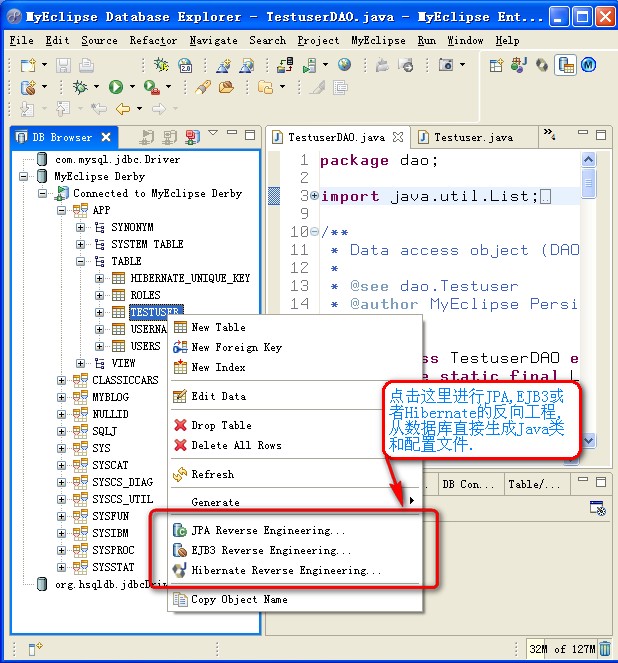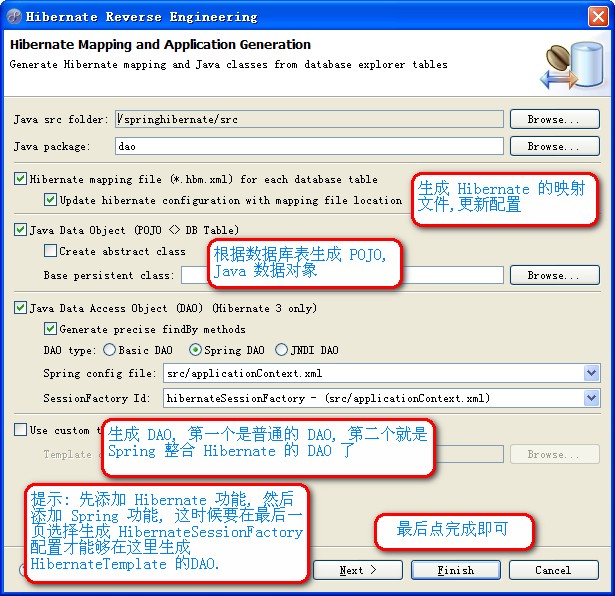今天介绍的第二个课题就是介绍 Spring 的快速开发, 说是快速开发, 其实能帮助的地方除了语法高亮和自动添加类库外也没多少东西了.
1. 新建普通 Java 项目 MySpringTest. 这个过程无需赘述了, 建议建项目的时候将 src 目录和 bin(或者classes)目录分开, 另外提示你切换透视图的时候一定要切换过去到 Java 透视图, 此时默认会在 Package Explorer 中选中刚才已经建好的 Java Project, 但是背景为灰色.
2. 首先单击一下左边的 Package Explorer 中新建的 MySpringTest 项目来使其高亮选中, 接着点击菜单项 MyEclipse -> Add Spring Capabilities..., 接着会弹出对话框 Add Spring Capabilities 提示你设置当前项目的 Spring 属性.
对话框的第一页可以选择全部的 Spring 框架, 这是最保险的做法, 不过我们的例子只需要选中Spring 2.0 Core Libraries 就可以了. 点击 "Next" 继续.
第二页是 Add Spring bean configuration file. 保持默认值不变就可以了. 最后点击 Finish.
3. Spring 的开发没法自动生成 Bean, 这里大家只好手工来写了, 也很简单. 分别复制下面的三个代码, 然后在 MyEclipse src 目录上点击右键后选择菜单项 Paste 就可以生成 Java 类文件了.
public interface Action {
public String execute(String str);
}
public class UpperAction implements Action {
private String message;
public String getMessage() {
return message;
}
public void setMessage(String string) {
message = string;
}
public String execute(String str) {
return (getMessage() + str).toUpperCase();
}
}
import org.springframework.context.ApplicationContext;
import org.springframework.context.support.ClassPathXmlApplicationContext;
public class TestAction {
public static void main(String[] args) {
ApplicationContext ctx = new ClassPathXmlApplicationContext(
"applicationContext.xml");
Action bean = (Action) ctx.getBean("theAction");
System.out.println(bean.execute("Rod"));
}
}
4. 双击左侧在第2步生成的 applicationContext.xml, 然后选择菜单项 Window -> Show View -> Other..., 在弹出的对话框中选择 MyEclipse Enterprise Workbench 节点下的 Spring Beans 子节点打开视图 Spring Beans. 此视图讲出现在主界面的右下侧.
5. 展开此视图中的 MySpringTest 父节点, 并选中 src/applicationContext.xml 子节点, 在此节点上点击右键并选择弹出菜单项中的 New Bean 来打开 Create a new Spring bean 对话框, 并按照下图输入对应的内容.
Bean Id: [theAction]
Bean class: [UpperAction]
接下来请单击一下 Tab 面板 Properties 并点击其中的 Add... 按钮, 在接下来弹出的 Property Wizard 对话框中按照下图输入/选择内容:
Name: [message]
Spring type: [value]
Type: [java.lang.String]
Value:[Hello_]
最后点击两次 Finish 按钮关闭所有向导对话框. 然后点击菜单 File -> Save. 此时可以看到 applicationContext.xml 的内容如下所示:
<?xml version="1.0" encoding="UTF-8"?>
<beans
xmlns="http://www.springframework.org/schema/beans"
xmlns:xsi="http://www.w3.org/2001/XMLSchema-instance"
xsi:schemaLocation="http://www.springframework.org/schema/beans http://www.springframework.org/schema/beans/spring-beans-2.0.xsd">
<bean id="theAction" class="UpperAction" abstract="false"
lazy-init="default" autowire="default" dependency-check="default">
<property name="message">
<value type="java.lang.String">Hello_</value>
</property>
</bean></beans>
然后双击 Package Explorer 下 MySpringTest/src/TestAction.java 打开源代码, 然后点击菜单 Run -> Run As -> 1. Java Application, 如果没有错误的话将会出现如下的输入, 您的第一个 Hello Spring 运行成功了:
log4j:WARN No appenders could be found for logger (org.springframework.context.support.ClassPathXmlApplicationContext).
log4j:WARN Please initialize the log4j system properly.
HELLO_ROD
接着您就可以对着参考书继续创建类, 修改 applicationContext.xml 做更多的练习了.
开发整合 Hibernate 的关键操作点截图:
1. 在数据库浏览器中选择反向工程菜单;

2. 对话框的选项说明

posted on 2007-08-02 07:47
BeanSoft 阅读(741)
评论(3) 编辑 收藏 引用 所属分类:
Spring 
posted on 2007-08-13 13:20
冬天出走的猪 阅读(3237)
评论(0) 编辑 收藏 所属分类:
spring